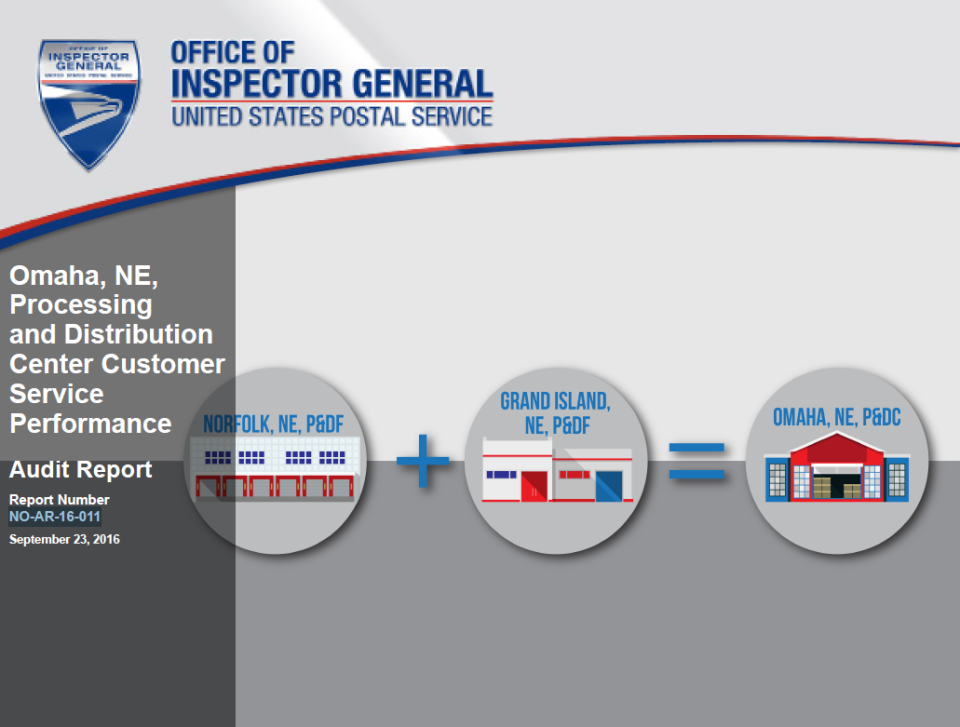Omaha, NE, Processing and Distribution Center Customer Service Performance
Background
The U.S. Postal Service uses Area Mail Processing (AMP) guidelines to determine whether to consolidate mail processing functions to reduce costs and maintain quality service.
In 2012, Postal Service management approved the AMP plan to consolidate the Norfolk, NE, and Grand Island, NE, processing and distribution facilities (P&DF) into the Omaha, NE, Processing and Distribution Center (P&DC). The Postal Service completed the originating (outgoing) mail consolidation in June 2013 and began the destinating (incoming) mail consolidation in April 2015. During this second consolidation phase, management decided to move a portion of destinating mail to the Lincoln, NE, P&DF.
On January 5, 2015, the Postal Service revised its First-Class Mail® (FCM) service standards, eliminating single-piece overnight FCM service and shifting some mail from a 2-Day to a 3-Day service standard. These revisions enabled the Postal Service to expand the amount of time each day that it could process mail, a change known as the operational window change (OWC).
In May 2015, Postal Service management suspended all consolidations and, as a result, the Norfolk and Grand Island P&DFs continued to process destinating letters to delivery order.
On March 3, 2016, Nebraska Congressman Jeff Fortenberry requested that we review the cause of ongoing mail service problems reported in the 1st Congressional District of Nebraska.
Our objective was to determine if consolidating the Norfolk and Grand Island P&DFs’ mail processing operations into the Omaha P&DC and Lincoln P&DF adversely affected customer service.
What the OIG Found
The June 2013 consolidation of the Norfolk and Grand Island P&DFs’ originating mail operations did not have a negative customer service impact. However, we did find that service performance declines corresponded to the OWC and the start of the destinating mail consolidation.
Specifically, the January 2015 OWC adversely impacted FCM service performance scores for letters, flats (large envelopes), and postcards. The service scores for Norfolk and Grand Island declined over 19 percent on average, to 68 percent from more than 87 percent a year earlier. In addition, in April 2015, when the destinating consolidation began, FCM service scores declined about 18 percent to 73 percent from over 91 percent a year earlier.
On June 30, 2016, FCM service performance scores were 88 percent, still below the 91 percent two years earlier. However, in Quarter 3, fiscal year 2016, FCM service performance significantly improved for the Norfolk and Grand Island P&DFs to above the national average for 3-5 day service.
We identified four managerial causes for the overall decline in FCM service performance.
First, management for the Norfolk and Grand Island P&DFs had not updated the plants’ operating plans to reflect the consolidations and the OWC. These plans define critical entry times and clearance times that establish the processing windows. Without up-to-date operating plans, management cannot determine proper staffing and scheduling to ensure all mail is processed timely.
Second, on April 13, 2016, we found the Grand Island P&DF had 1,818 FCM letters that were not dispatched on time or recorded as delayed on the daily mail condition report. This occurred because no on-site manager was overseeing mail dispatches and the daily mail condition report count.
Third, during our April 2016 site visit, we observed mail arriving in Omaha from other originating processing facilities too late to be processed for its intended delivery day. From January through April 2016, the Omaha P&DC recorded an average of 3,604 trays of mail per month as late arriving. The Omaha P&DC does not have a system in place to notify origin facilities of late arriving mail so they can correct the causes of delays.
Finally, the Omaha P&DC was not meeting the established processing times to meet service commitments. This occurred because mail processing managers and supervisors were not following machine processing and maintenance schedules developed with the run plan generator.
Delayed mail increases the risk customers will lose confidence in the Postal Service’s ability to provide trusted and reliable service. This could directly harm the Postal Service’s brand, lead customers to seek alternative delivery options or use digital alternatives, and, ultimately, reduce revenue.
What the OIG Recommended
We recommended management ensure the Norfolk and Grand Island P&DFs update their operating plans and ensure mail is dispatched timely and delayed mail is correctly recorded on the daily mail condition report. We also made recommendations in another report concerning the tracking and processing of late arriving mail and have initiated a separate audit focused on use of the run plan generator. Therefore, we are not making recommendations in this report about these two issues.

